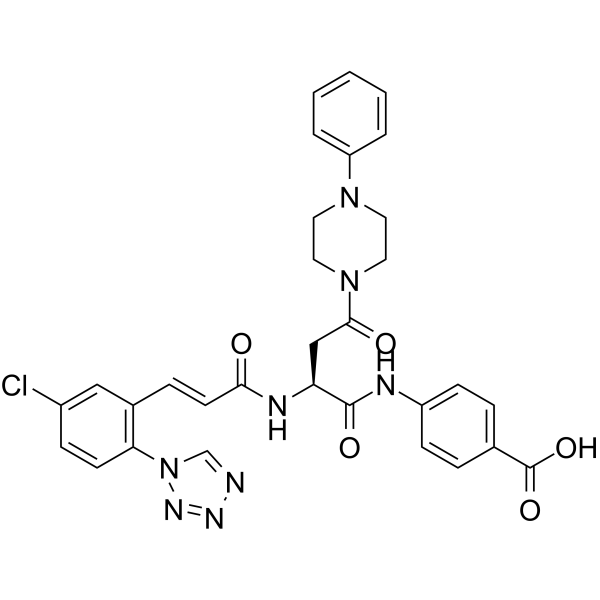| In Vivo |
FXIa-IN-8 shows selectivity for FXIa and PKal with IC50s of 14.2, 27900 nM, respectively[1]. FXIa-IN-8 (6.5, 19.5 mg/kg; i.v.) shows antithrombotic activity in vivo[1]. FXIa-IN-8 (50, 100 mg/kg; i.v.) shows no acute toxicity[1]. FXIa-IN-8 (10 mg/kg; i.v.) shows moderate PK profiles[1].FXIa-IN-8 (19.5, 39 mg/kg) exhibits a much lower bleeding risk than heparin sodium at 300 IU/kg[1]. Pharmacokinetic Parameters of FXIa-IN-8 in Male SD rats[1]. compd 35 T1/2 (h) Cmax (µg/mL) AUC0-t (h·µg/mL) AUC0-∞ (h·µg/mL) Vz(mL/kg) Cl (mL/h/kg) MRT0-t (h) i.v. (10 mg/kg) 1.26 57 18.3 18.4 969 553 0.32Male SD rats; 10 mg/kg for i.v.[1]. Animal Model: Male SD rats[1] Dosage: 10 mg/kg (300 IU/kg (2.7 mg/kg) heparin sodium were injected into the tail vein 10 min before surgery) Administration: I.v. Result: Showed moderate PK profiles with a half-life value (T1/2) of 1.26 h and a clearance (Cl) value of 553 mL/h/kg. Animal Model: C57BL/6J mice (FeCl3-induced carotid artery thrombus model)[1] Dosage: 6.5, 19.5 mg/kg Administration: I.v. Result: Slightly prolonged the time of occlusion at 6.5 mg/kg, and showed excellent antithrombotic activity at 35 mg/kg. Animal Model: ICR mice[1] Dosage: 50, 100 mg/kg Administration: I.v. Result: Showed no obvious toxic reaction to different tissues of mice. Animal Model: C57BL/6J mice[1] Dosage: 19.5, 39, 20, 60, 100 mg/kg Administration: I.v. Result: Showed a low bleeding risk at 60 and 100 mg/kg.
|
